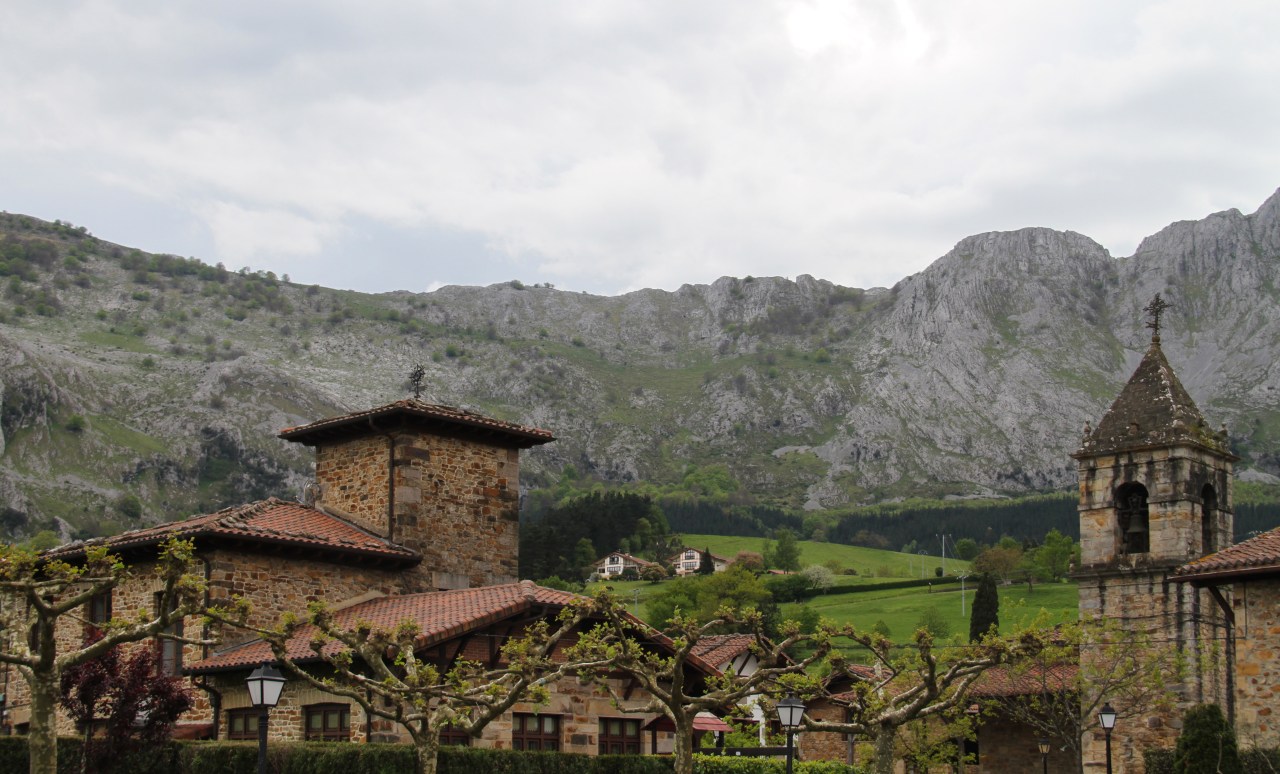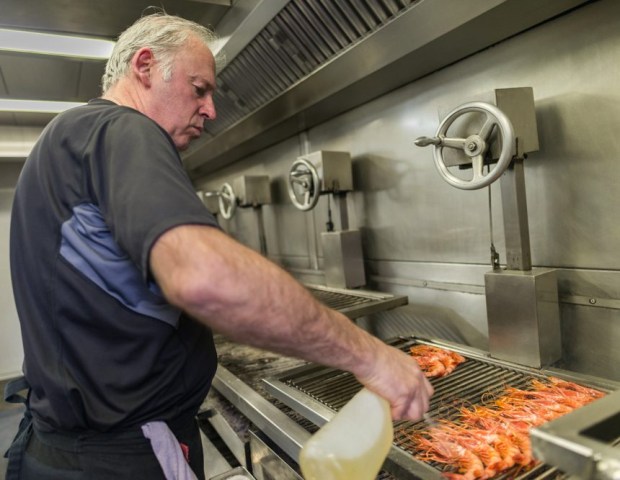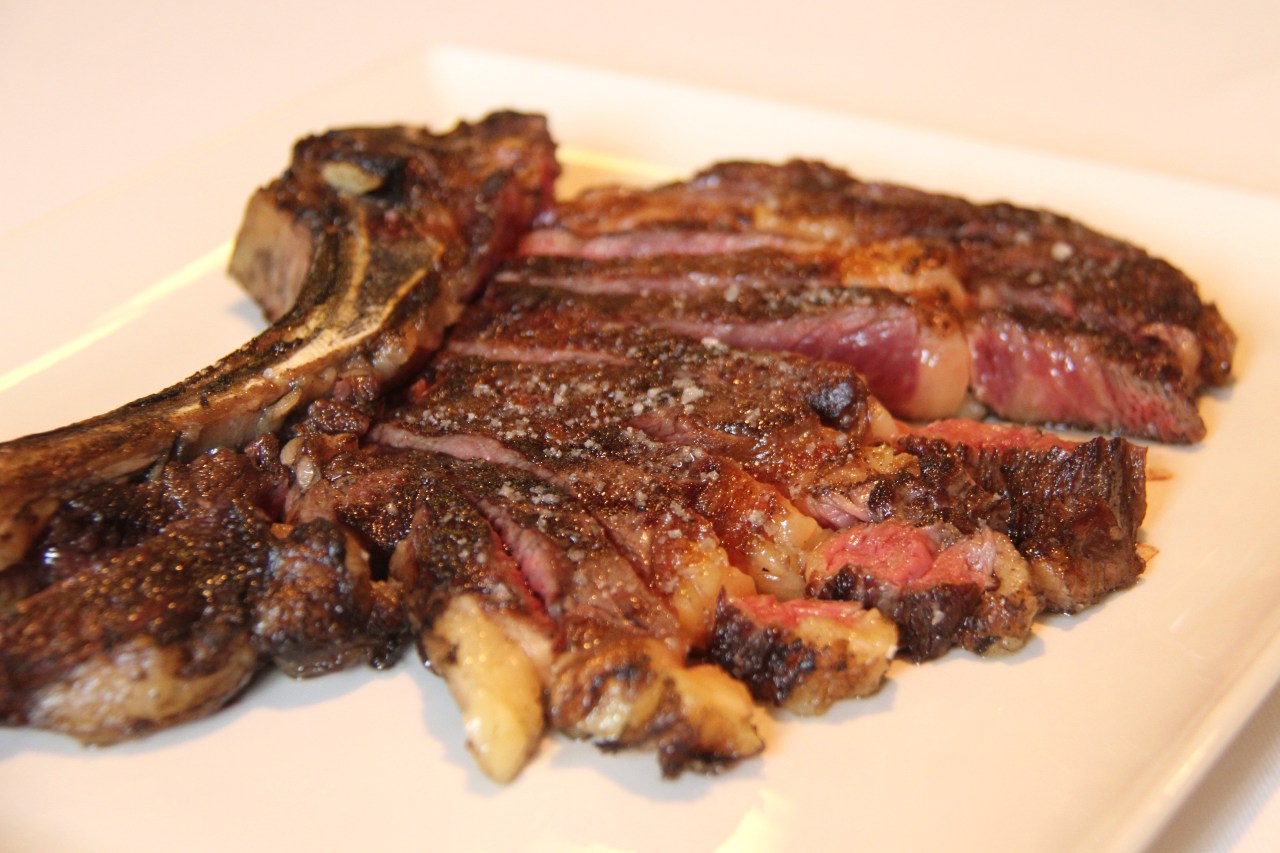Pan y mantequilla (bread and butter)
It’s just butter. That’s what I tell myself over and over as I watch it vanish from the little cold stone it comes riding in on. But really, it’s not just butter. It’s butter that came from a goat just outside the grassy hill to my left, made from cream that spent hours slowly smoking in the dying embers of an oak fire, then churned downstairs into fine ivory ribbons, pressed into a rectangle and dusted with ash from a nearby volcano. It is not just butter; it’s a mission statement.
The man behind the edible manifesto, Bittor Aguinzoniz, was once a high-mountain ranger, charged with watching over the forests of the upper Basque Country. But as he tended to the earth, he had another idea slowly burning in his mind. He couldn’t stop thinking about that old farmhouse in his hometown of Axpe, a one-road, five-house village of impossible bucolic perfection; the beautiful stone structure in the lone plaza that once housed a bar had been abandoned. Wouldn’t that make a fine establishment, he told himself after long hours in the woods.
It remained abandoned for 11 years until Bittor said goodbye to the forest and bought the building in 1990. He wasn’t a cook by trade, but that didn’t bother him. He had a story he wanted to tell.
If butter was all that you tasted, you would understand a good chunk of Bittor’s story, his generous vision, and prodigious talent. With a few bites, you could taste at least a suggestion of why people call Etxebarri an altar and Victor a priest who practices a religion of smoke and fire.
But it’s not just butter. Butter is just the beginning.
Ostra a la Brasa (grilled oyster)
Consider the oyster. An oyster is as near-perfect in its raw state as any ingredient on the planet. If you cook an oyster, you are either dumb, incapable of locating oysters worth eating raw, or possessed of the belief that you can improve upon one of nature’s finest creations. If it’s the latter, you are either delusional, or you are Bittor Arguinzoniz.
Most serious eaters come to the Basque Country to eat pintxos and splash out on Michelin temples of modernist cuisine, but Northern Spain is home to one of the planet’s great grill cultures. This is a world where asadores, restaurants focused on simple, honest cooking over the fire, play an outsize role in the local culinary and social fabric. But to truly experience the wonders of Spain’s asadores, you need to travel outside of the urban areas into the rural reaches of the north, and there are few places more rural than Axpe.

Bittor wanted a simple asador befitting the restaurant’s village location. But simple didn’t mean easy. It took time for Bittor to sharpen his skills. He wasn’t born into the kitchen. He grew up a few steps from the restaurant, in a home powered by candles and firewood. His mother and grandmother cooked everything over embers—vegetables from the garden, stews, fish. “My earliest memories are of the hearth and the smell of burning wood.”
Bittor began with classic Basque dishes: sole, hake cheeks, turbot, thick-cut, bone-in steaks. The most important ingredient, then and now, was the source of heat: not charcoal. Never charcoal. “Charcoal is the enemy. It destroys whatever delicate, subtle flavors you find in the best ingredients.”
Instead, he chops his own wood and builds large fires in an oven inside the kitchen, which provides the fuel for the day’s cooking. He uses two types of wood: oak, for the more delicate nature of fish and seafood, and vine clippings, which burn hotter and impart more assertive flavors on beef, lamb, cured pork. In his transformation from ranger to cook, one idea possessed Bittor: harnessing fire in a way no one else ever had.
“In the flames of the fire lives something that can help ingredients reach their fullest potential.”
He doesn’t do much to the oyster—he opens it, places it over a small bed of embers, leaves it to gently simmer in its own liquor until the muscle firms up and the juices reduce. When you bite in, the oyster exhales and a warm tide of umami comes rushing out—an undeniable improvement on nature’s remarkable design.
Huevos Revueltos con XiXi (scrambled eggs with St George’s mushrooms)

When Bittor woke up this morning, these eggs did not exist. His chickens laid them sometime between his first coffee and the pre-lunch wood chopping. He warms them gently over the fire, just long enough for them to coagulate but not so long that they take shape, then shaves the mushrooms over the top as if they were truffles (if truffles were in season, they would be truffles).
It doesn’t look like much on the plate, it doesn’t sound like much on the page, but you have never tasted an egg like this—a blanket of warm, earthy intensity, like a high-mountain hollandaise, with the faintest whisper of the forest floor from the slices of rare Basque fungus.
To understand the dish, you need to understand the quiet ambition of Bittor. He could have cooked brilliant steaks and whole fish for a loyal local clientele for 40 years and called it a career. But he didn’t leave the forest for that.
Etxebarri opened just as Ferran Adrià and his band of young culinary rebels were ushering in a new age of modernist cuisine that would make Spain the most talked-about food destination for years to come. Bittor says he took inspiration from Ferran—not in the elaborate, hifalutin cuisine of the new Spanish kitchen, but in the philosophy that drove it, one that espoused boundless innovation and a thorough reexamination of traditional cooking techniques. He wanted to apply this ethos to the humble origins of the asador, which meant expanding the definition of the grill itself. He found a conventional grill to be limiting, so he designed his own—complete with a system of hand cranks to raise and lower the stainless-steel grates into the teeth of the fire. But even a modified grill can only cook so much, and so he created special implements for cooking ingredients not normally subjected to live fire: wire baskets for vegetables and fragile seafood, thin screens with glass domes that allowed him to gently smoke delicate ingredients, new vessels for unconventional tasks like scrambling eggs over an open flame. Depending on the time of year you come, you may eat tiny baby eels, sea cucumbers, or lightly smoked caviar. In Bittor’s world, nothing is beyond the reach of fire.
Guisantes de Lagrima: teardrop peas
The thimble of baby peas, like all the dishes at Etxebarri, arrives on a dumbwaiter. Bittor’s wife, the main server in the restaurant, picks them up and places them before each guest. Below in the kitchen, a team of five cooks looks over every plate before it’s sent upstairs. These apprentices come from all over the world these days, looking for a chance to cook alongside the master.
But they don’t cook. Not really. They certainly don’t grill. And they don’t create. “They know not to come to me with new ideas,” says Bittor—not out of defiance or arrogance, but out of a sincere desire to be behind every plate of food served. “You’ve made the effort to come to my house and I need to cook for you. I know many chefs don’t want to hear it, but it’s true.”
Instead, the cooks mostly hang out on the fringes of the kitchen, working like expeditors: garnishing plates, whispering nervously among themselves, hoping the man’s genius will seep into their pores like the wisps of smoke floating through the kitchen.
Bittor has his own ideas on how things should taste. These peas, for example—perhaps the most emblematic expressions of Bittor’s food and philosophy. The peas come from his garden, almost perfect to begin with. How can I make them taste just a little bit more like peas? he wonders. He shells them, then lightly grills the pods and makes a stock from them to extract all the extra pea flavor. He floats the baby peas in the smoked pea-pod stock and lets it bubble gently over the fire until the peas are just warmed through. Eaten with a small silver spoon, they pop on the roof of your mouth like vegetable caviar.
Peas. Water. Salt. 1 + 1 + 1 = 5, the basic equation at the heart of all Bittor’s alchemy.

Gambas de Palamós (red shrimp from Palamós)
“You can’t spend a lot of time staring at your belly button. There are good products everywhere.” What Bittor means is that he’s not evangelical about where his ingredients come from. If the best asparagus grows next door, he’ll go pluck it there; if it’s hundreds of miles north in central France, then he’ll find a way to get it.
The best shrimp comes from Palamós. Bittor spends a lot of time worrying about this shrimp—the famous red shrimp from the shallow waters of the Catalan coastline, sweet, tender, and dense with umami, unrivaled in the world of crustaceans. If it doesn’t arrive in prime condition, then it doesn’t go on the menu, and that’s bad news for everyone.
Every chef in the world will tell you that he or she takes inspiration from the ingredients, that the items speak to them and they simply listen. It’s boilerplate chef speak in a food world obsessed by pedigree and appearances. In most cases, chefs will take those talkative ingredients and manipulate them to within an inch of their lives. In the case of Bittor, where so many dishes contain just two elements (product + salt), he truly listens.
Once he finds the good stuff, it’s a matter of heat transference, combining temperature and time in precise measure until an ingredient hits its peak. This is Bittor’s specialty.
Bittor’s primary cooking instrument is his eyes. He doesn’t trust thermometers or scales or anything that tells him something he can discern for himself. “Everything is done by eye. The product needs to talk to you. It tells you when it’s done—nothing else matters.” In the case of the shrimp, the most delicate of sea treasures, he stares at them with such unwavering intensity that you’d think his pupils were the heat source.
When they arrive at the table, you rip their heads off, furiously suck out the molten brains—“the sauce that God made,” as Bourdain calls it—then move on to those gorgeous bodies, cooked just past translucent. If you can eat these giant red shrimp from Palamós and not lose yourself just a little bit, then you’re stronger than I am.
Chuletón de Vaca (dry-aged rib steak)

A caveman steak caps the savory section of every meal at Etxebarri. From grass-fed Galician beef, aged 21-30 days, and cooked over wine clippings using Bittor’s intense eyeball technique. “I dump a ton of salt on it and the meat absorbs only what it needs. I cook it over a medium flame and I don’t rest it, which is very important. If you rest the meat, it continues to cook and it will lose juice. I slice it and serve it right away.”
Other chefs will tell you the exact opposite—extolling the need to rest meat to allow the juices to resettle before cutting into the steak—but Bittor has made a career of doing the opposite of what everyone else does, and it’s impossible to argue the results: burgundy and warm on the inside, dark and crusty exterior, with a sliver of sweet fat on the edge of every bite adding a savory caramel coat to the gentle funk of the aged meat. At any given moment in the Etxebarri dining room, you’ll see groups of locals and foreigners alike, scraping the bones, shaking their heads, wondering how it can be this good.
In case you didn’t get the picture, Spain is deadly serious about eating. From the sierras of Andalucia to the rocky coastlines of Cantabria you will find a nation whose social fabric is built around food and drink. The Catalans have festivals dedicated to burnt onions. Valencians will disown family members if they add black pepper to the paella. Madrileños can spend five or six hours at the dinner table without so much as glancing at their phones. But nobody is more serious about food than the Basques, who consider world-class cuisine and great company and long hours at the table a fundamental human right. They spend more of their income on food than anyone in Spain (19 percent compared to 13 for the rest of the country), and it shows—everywhere you turn, you’ll see groups of young friends and families and old couples partaking in the edible delights of what they consider to be a piece of the planet uniquely blessed by the gods of food and wine.
And every bite of this beef proves them correct.
Gin Tonic
Not kissed by smoke, not fucked by flame, not grown in the garden next door. Just a few massive cubes of ice, three fingers of Beefeater, and a splash of Schweppes. It’s how Spaniards end a big meal, a digestivo that makes everything feel better.
If the world were coming to an end tomorrow, I’d catch the first train to the Basque Country and wind my way up to Axpe, settle into the table, and eat until I expired. I am not alone in this belief. Many chefs I know who have been here feel the same about the primal pleasures of Etxebarri. Nearly everything that Bittor cooks—from garden peas to giant shrimp to ice cream made with milk from his own buffaloes, smoked in the last ashes of the day’s fire—is a category killer. For a long time, he killed categories in relative obscurity, but the rest of the world has caught on in recent years. During that time, Bittor added a sommelier, upgraded the dining room, made a few changes to the service and ambiance befitting of its soaring stature. The controversial chef- and critic-fueled San Pellegrino list ranks Etxebarri as the fifth-best restaurant in the world.
None of this changes Bittor or what he does. If anything, it’s a nuisance, a distraction from the very serious task of cooking every piece of food that leaves the kitchen himself. Bittor cuts a decidedly different figure than the globe-trotting, multi-discipline, media-savvy modern chef. He’s an artisan, what the Japanese would call a shokunin, a man deeply dedicated to a singular craft. Don’t expect to see him on television or on the speaking circuit anytime soon. “Chefs today are businessmen. I’m always here, because my place is here. You can’t cover two seats with one butt. You’ve come from 4,000 miles away and I’m not here to cook for you? That’s a lack of respect.”
He spends six days a week, 12 hours a day tending to the fire. He takes one day off, Monday, which he invariably spends hiking to the top of one of the granite peaks that you can see from the dining room. Anything that distracts from his personal pursuit of perfection is unwelcome. Including—especially—journalists. I’ve met Bittor many times over the years, done stories with him, drank gin and tonics with him in the bar downstairs. He’s unfailingly polite and thoughtful, but he suffers through interviews like you and me suffer through dental work. While he tries to give you his full attention, you can see his mind working out the problems of the next meal: The rib steaks need a few more days of aging. Soon the sugar will turn to starch in the peas. What if tomorrow’s shrimp aren’t as fat and sweet? Need to chop more wood.